Biography of William Stukeley 1687-1765
William Stukeley 1687-1765 is in Antiquaries.
3000BC. The Sanctuary [Map] is fifty-eight stone-sockets and sixty-two post-holes forming concentric circles located at the southern end of the West Kennet Avenue on Overton Hill next to the Ridgeway Path. The overall diameter is 40m. William Stukeley reported in 1724 that locals called it The Sanctuary. From The Sanctuary may be seen West Kennet Long Barrow [Map], East Kennet Long Barrow [Map] and Windmill Hill Causewayed Enclosure [Map].
The The Sanctuary [Map] is notable for being where the River Kennet and the Ridgeway Path cross.
Around 3000BC a ring of eight wooden posts 4.5m across with a central post was constructed at The Sanctuary [Map]; possibly a round building.
Before 2800BC the first ring was englarged to 6m and a second ring of eight posts of diameter 11.2m was added to The Sanctuary [Map].
After 2800BC a 21m diameter circle of 33 posts was added, and at the same time an inner stone circle of 15 or 16 sarsen stones was added to The Sanctuary [Map] alongside the now middle ring.
Around 2400BC 42 sarsen stones forming a boundary ring 40m across replaced all the timber structures. Possibly around the same time West Kennet Avenue was constructed.
On 07 Nov 1687 William Stukeley was born to John Stukeley and Daughter Bullen at Holbeach, Lioncolnshire.
In 1705 [his father] John Stukeley died.
In 1707 [his mother] Daughter Bullen died.
In 1718 William Stukeley (age 30) was elected Secretary of the Society of Antiquaries of London.
Minutes of the Society of Antiquaries. 07 May 1718. Bought by the Society the Portrait of Edwrd the Third for a Guinea which Mr [his future brother-in-law] Treasurer (age 35) is ordered to pay.
Mr Bostue had the Drawing of Richard II delivered to him by Mr Director (age 40) in order for engraving, for which he is to be paid Twenty Guineas. Mr Director [?] gives the use of the Drawing to the Society.
In order to defray the expenses, it is found necessary to raise a voluntary Subscription of Seven Shillings and Six Pence aa [?] of as many [?], for which they [?] the equivalent in prints of the same when finished.
Mr Vertue (age 34) gives the Copper Plate, he is to be paid five Guineas down, five guineas when half finished, and the rest uponm delivery.
In the margin: Pictures of Henry VII and Eliza: his wife
Bought by the Society of Dr Stukeley (age 30), Secretary, an old picture of Elizabeth wife of Harry VII for £12 0s 6d which Mr Tresurer is order to pay.
Bought by the Society an old picture of Henry VII for £1 0s 4d which Mr Treasurer (age 35) is ordered to pay to Mr Norroy (age 57).
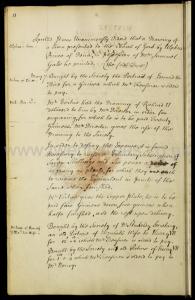
Minutes of the Society of Antiquaries. 14 May 1718. Mr Borkol [?] informed us his trees in Dean's Yard, Westminster were planted by Dr Feckenham last Abbot of Westminster.
Mr Gosling presented each Member with a print from his two Plates of Lord Bacon, for which thanks of the Society are returned to him, and Mr Director (age 40) is ordered to present him with a couple of prints of St James' Font in their names.
Mr President (age 57) exhibited a curious ancient deed, dated MCLXXVI [1426] 22:H:II being a Pacification between the Abbot of Canterbury and the men of the Isle of Thanet whereto are 124 witnesses cum pluribus alus[?] [with more]. Tis printed in the Dorom Scriptures into Chronica [?] p 1827. Edit 1652 but without the Witnesses.
The Secretary (age 30) read a letter which gives an Account of a fine font in Ely Cathedral [Map], vast numbers of beautiful and with other monuments there, some pretty ancient. Opposite the door of the North Cross Isle, the pictures of the Archbishop of York, the Earl of Northumberland, and [?] other Bps [Bishops] who held out the Town against William the Conq. They are very ancient and pretty entire.

Minutes of the Society of Antiquaries. 27 Aug 1718. Dr Sukeley (age 30) brought a brass Roman Lingula or Spoon, found at Reculver [Map] in Kent given him by Mr Anthony Knightly, Druggist in Newgate Street, whose father took it up.
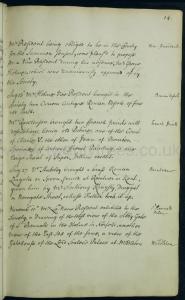
Minutes of the Society of Antiquaries. 07 Jan 1719. The Society Balloted for the Officers for this Year ensuing and the present President (age 57), Secretary (age 31), Director (age 41), and [his future brother-in-law] Treasurer (age 36) were unanimously Elected and declared.
The Question being proposed wheather or no, any member should have liberty to subscribe for prints in a larger than common proportion, it by way of ballot carryed in the Negative.
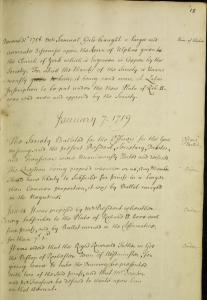
Vesta Monumenta. Plate 1.7: Engraving of Waltham Cross [Map]
Plate 1.7 of Vetusta Monumenta depicts the Waltham Cross, one of the twelve monuments that Edward I ordered to be built between 1291 and 1294 to commemorate the funeral procession of Queen Eleanor. The print documents the early preservation efforts of the Society of Antiquaries of London. The cross was re-engraved by James Basire Sr. after Jacob Schnebbelie for the third volume of Vetusta Monumenta (Plate 3.16), where it appears with two more of the Eleanor Crosses. Engraving by George Vertue (age 37) after William Stukeley (age 33). 490 x 301 mm. Published by the Society of Antiquaries of London in 1721. Current location: Waltham Cross, Hertfordshire, UK.
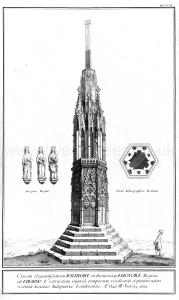
In 1723 Stukeley (age 35) described Hautville's Quoit [Map] as being 4m long. It is now half that.
1723. "Prospect of Camalet Castle" aka Cadbury Castle, Somerset [Map] by William Stukeley (age 35).

Amesbury 42 Long Barrow [Map] is a Long Barrow at the end of the Stonehenge Greater Cursus. It was noted by William Stukeley (age 35) in 1723 and Richard Colt Hoare 2nd Baronet (age 51) in 1810. It was excavated by John Thurnam in 1810 who recovered an Ox Skull and discovered secondary inhumations. The barrow is now levelled.
On 11 Jul 1723 William Stukeley (age 35) drew Silbury Hill [Map] and wrote that a skeleton and bridle had been discovered during tree planting on the summit. The feature noted 'B' or the Snakes Head or Hakpen is The Sanctuary [Map].
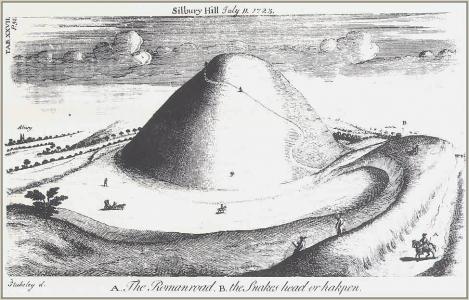
On 23 Jul 1723 William Stukeley (age 35) made sketches of Stanton Drew Great Circle [Map].
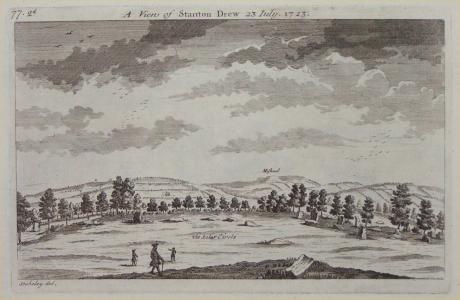
Avebury by William Stukeley. by William Stukeley (age 36), M.D. Rector of All-Saints [Map] in Stamford.
Antiquity 1935 Volume 9 Issue 33 Pages 22-32. 1724. Stukeley's (age 36) original field-sketch of the plan of the Overton Hill stone circles [Map]. Bodleian Library, M.S Gough Maps 231. f. 54r.
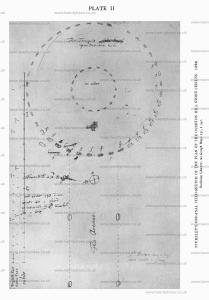
Antiquity 1935 Volume 9 Issue 33 Pages 22-32. 1724. Stukeley's (age 36) original field-sketch of the plan of the Overton Hill stone circles [Map]. Bodleian Library, M.S Gough Maps 231, f. 9v.
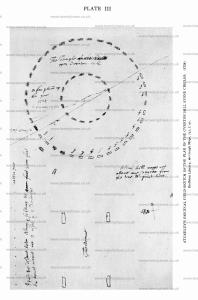
Cumbria and Westmorland Antiquarian and Archaeological Society. 1725. The next observer in order of date is Stukeley (age 37), who in 1725 says:- 1
"Mr. Patten and I went to view that fameous monument of antiquity called Long Meg and her Daughters [Map], in the parish of Aldingham, between Little Salkeld and Glassenby. It stands upon a barren elevated plain of high ground, under the vast hill called Crossfell to the east. This plain declines to the east gently, or rather north-east, for that I find to be the principal line observed by the founders. It is a great Celtic temple, being a circle of 300 feet in diameter, consisting of 100 stones: they are of unequal bulk: some are of very large dimensions: many are standing, but more fallen, and several carried away: but lately they have destroyed some by blasting, as they call it, i.e. blowing them in pieces with gunpowder; others they have sawed for mill stones: but the major part remaining, gives one a great idea of the whole; and it is a most noble work. The stones are not all of the same kind: some made of square crystallisations, (of the same sort as those at Shap) and I saw many of that sort of stone scattered about the country: others of the blue hard flaky sort, like those of the temple at Mayborough. The intervals are not exactly equal, but judiciously adapted to the bulks of the stones, to preserve as much as possible a regular appearance. This large ring thus declining north-east is now parted through by a ditch, so that the larger half lies in an inclosure, the other in a common; and the road lies by the side of it, that goes from Little Salkeld to Glassenby. South-west from it seventy foot, stands a very great and high stone, called Long Meg [Map], of a reddish grit, seeming to have been from the side of some quarry of the country: I think it leans a little north-east; it is about fifteen foot high. In the middle of the circle, are two roundish plots of ground, of a different colour from the rest apparently, and more stoney and barren, which probably were the immediate places of burning the sacrifices or the like. Not far from hence toward Glassenby is a very fine spring: whence no doubt, they had the element of water, used at their religious solemnities: and higher up the field is a large spring, intrenched about with a vallum and foss, of a pretty great circumference, but no depth. Full south-west from this work, in the next enclosure and higher ground, is another circle of lesser stones in number twenty: the circle is 50 foot diameter: and at some distance above it is another stone placed regarding it, as Meg does the larger circle. In that part of the greater circle next the single stone, called Meg, are two stones standing beyond the circle a little, and another fallen: which I believe were a sort of sacellum, perhaps for the pontifex to officiate in: and westward is another stone or two, perhaps of a like work: but the ruinous condition of the work would not admit of any certainty about it."
Note 1. Iter curiosum, ed. of 1776, Vol. II, P. 47.
1725. William Stukeley (age 37) sketched King Arthur's Round Table, Mayburgh Henge [Map] and Little Round Table.
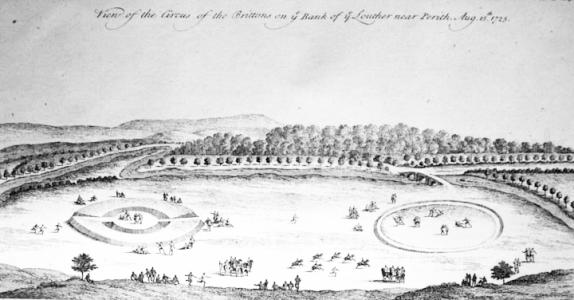
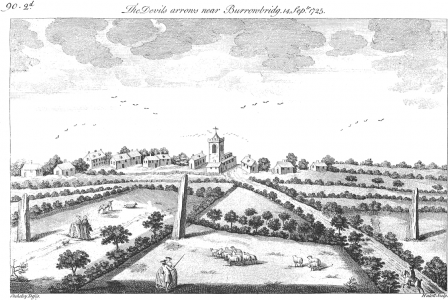 14 Sep 1725. Drawing of the The Devil's Arrow's [Map] by William Stukeley (age 37).
14 Sep 1725. Drawing of the The Devil's Arrow's [Map] by William Stukeley (age 37).
In Dec 1727 William Stukeley (age 40) and Frances Williamson (age 30) were married.
On 20 Jul 1729 William Stukeley (age 41) was ordained as a Deacon by Archbishop William Wake (age 72).
In Oct 1729 William Stukeley (age 41) was granted the living of All Saints Church, Stamford [Map] by Peter King 1st Baron King (age 60).
Antiquity 1935 Volume 9 Issue 33 Pages 22-32. William Stukeley (age 42) and his Wife Frances (age 33). Drawing by Stukeley (age 42) in a MS Genealogy (c. 1730) in the possession of Alexander Keiller.
Frances Williamson: Around 1697 she was born. In Dec 1727 William Stukeley and she were married. In 1737 she died.
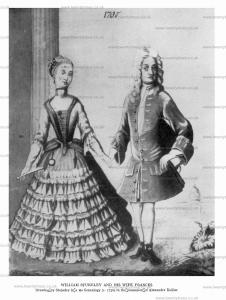
On 28 Aug 1736 William Stukeley (age 48) visited the Cotterstock Roman Mosaic at Cotterstock with George Lynn who lived nearby at .
In 1737 [his wife] Frances Williamson (age 40) died.
Vesta Monumenta. 1738. Plate 1.49. Bishop's Palace, Hereford. Drawn by William Stukeley (age 50) in 1721. Engraved by George Vertue (age 54). The chapel was demolished by 1746 except for the north wall, which is adjacent to the cloister.

In 1739 William Stukeley (age 51) and Elizabeth Gale (age 51) were married. She the sister of his great friend Samuel Gale (age 56). She brought a substantial marriage portion to the marriage.
Stonehenge by William Stukeley. Stonehenge A Temple Restored To The British Druids By William Stukeley (age 52). Rector Of All Saints In Stamford. To His Grace Peregrine Duke Of Ancaster And Kesteven (age 25), Hereditary Lord Great Chamberlain Of England, &C. &C. London: Printed For W. Innys And R. Manby, At The West End Of St. Paul's. MDCCXL.
Antiquity 1935 Volume 9 Issue 33 Pages 22-32. 1740. William Stukeley (age 52). For the published plate of the Overton Hill Stone Circles [Map], though not the final version, showing the corcles altered to oval. MS in the possession of Alexander Keiller. See Avebury Chapter VIII.
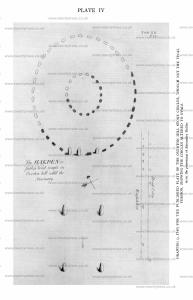
Between 1740 and 1748 William Stukeley (age 52) lived in a house on the site of 10 Barn Hill, Stamford [Map] whilst Vicar of All Saints Church, Stamford [Map], as recorded by a Blue Plaque.
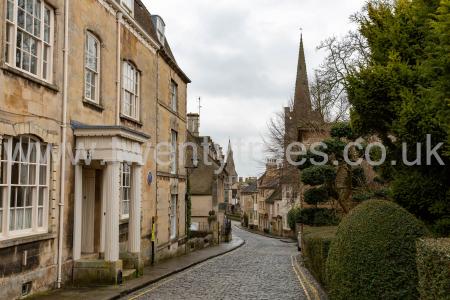
Antiquity 1935 Volume 9 Issue 33 Pages 22-32. 1743. William Stukeley (age 55). Overton Hill Stone Circles [Map]: Plan published in Stukeley's 'Avebury'. Tab XX..
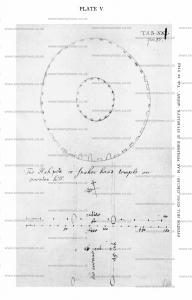
Around Nov 1747 William Stukeley (age 59) became Rector of St George the Martyr Church, Bloomsbury.
Wiltshire Archaeological Magazine 1857 V4 Pages 307-363. It was reserved for Dr. Stukeley1 to give to the world, in 1748, a detailed account of the plan upon which the temple at Abury was constructed. He spent much time on the spot, surveyed it thoroughly, reckoned the stones which were standing, those which were prostrate, and the hollow places indicating the sites of those which had been destroyed. And this he did not merely within the vallum, but in the avenues and the "Sanctuary [Map]" (as it was called) on Kennet Hill. " When I frequented this place," he says, "as I did for some years together, to take an exact account of it, staying a fortnight at a time, I found out the entire work by degrees. The second time I was here, an avenue was a new amusement. The third year another. So that at length I discover'd the mystery of it, properly speaking; which was, that the whole figure represented a snake transmitted thro" a circle; this is an hieroglyphic, or symbol of highest note and antiquity."
Note 1. The Rev. Wm. Stukeley (age 60), M.D., was born at Holbech in Lincolnshire, Noy. 7th, 1687. He was admitted into Bene't College, Cambridge, Nov. 7th, 1703, and chosen scholar there in April following. He applied himself to the study of medicine and anatomy and took the degree of M.B, in 1709, and of M.D, in 1719. He practised for some time in Boston, in London, and in Grantham. In 1728 he married Miss Frances Williamson of Allington, near Grantham. Suffering much from the gout during the winter months, it was customary with him to take several journeys in the spring, in which he indulged his innate love of antiquities. The fruit of these travels was the fol. "Itinerarium Curiosum," Centuria I., London, 1724. The 2nd volume was published in 1776, after his death. In 1729 he was ordained by Archbishop Wake and presented by Lord Chancellor King to the living of All Saints, Stamford. In 1787 he lost his wife, and in 1738 he married the only daughter of Dr. Gale, Dean of York. In 1740 he published his account of Stonehenge, and in 1743 his description of Abury. In 1747 he vacated his preferments in the country, being presented by the Duke of Montagu to the Rectory of St. George's, Queen Square, London. On the 27th of February, 1765, Dr. Stukeley was seized with a paralytic stroke, of which he died on the 3rd of March in his 78th year. He was buried, by his own desire, in the Churchyard of East Ham, in Essex. He left three daughters by his first wife, but had no child by the second. (Vide Nichols's Lit, Aneed. vol. v.) Dr. Stukeley's MSS. were for some time in the possession of the late Mr. Britton, and it is understood that a little before his death, he disposed of them to one of the representatives of the Doctor's family. It is to be hoped that they may be subjected to a careful examination, with a view to the publication of such portions as may still possess an antiquarian value.
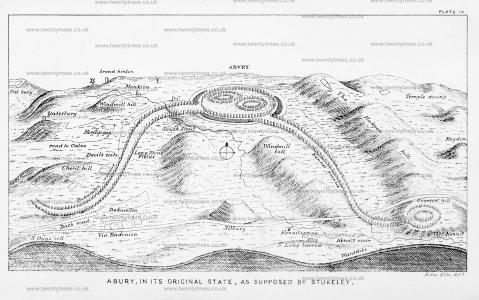
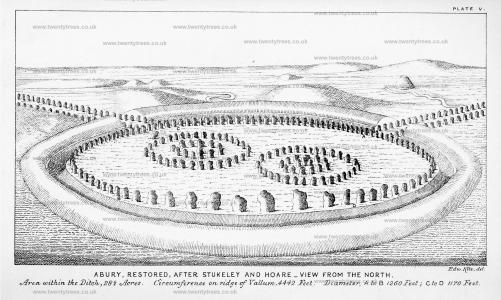
On 10 Jan 1754 [his brother-in-law] Samuel Gale (age 71) died.
Before 22 Sep 1757 [his wife] Elizabeth Gale (age 70) died.
On 03 Mar 1765 William Stukeley (age 77) died.
Iter Boreale by William Stukeley was published posthumously in Itinerarium Curiosum, 2nd.ed., 1776,
Diary of a Dean by Merewether. It may be deemed no unprofitable appropriation of our space and time, to give a brief statement of the number of stones originally composing this magnificent temple, what Dr. Stukeley observed, and what we have found there.
The original outer circle was formed of 100 stones; within this were two smaller circles [Avebury North Circle and Avebury South Circle], not concentric, of (each) 30 stones; within each of these a smaller concentric circle, each of 12 stones; in the centre of the northern inner circle were 3 stones [Map]; in the centre of the southern inner circle 1 stone [Map].
Besides these, each avenue was composed of 200 stones, terminating towards the east on Hacpen Hill, in a double oval, the outer containing 40 stones, the inner 18 stones; in the western range were 2 extra stones about half way, forming as it were a recess; and 1 at the termination.
Antiquity 1935 Volume 9 Issue 33 Pages 22-32. Easily the greatest of these early antiquaries was William Stukeley, and few individuals have left posterity such a mass of potential biographical material. While his published works are relatively few, he zealously kept every scrap of his own manuscript writings, his drawings, the proofs of his published engravings; his correspondence with antiquaries of the day; numerous notebooks, and twenty volumes of his diary, as well as two autobiographical essays. The main bulk of these papers was preserved by his descendants, the St. Johns of Dinmore Court, Herefordshire, and, with some additional material from other sources, were utilized by W. C. Lukis in his edition of The Family Memoirs of the Rev. William Stukeley, M.D. prepared for the Surtees Society in 1882-7. In 1924, some of the Dinmore Court MSS. were presented to the Bodleian1 (which already possessed, in the Gough topographical collections, several important Stukeley MSS.); others were purchased by that Library and by Mr Alexander Keiller (age 45), who has since acquired additional MSS. from time to time.2 With such a plethora of material it is obviously impossible, in the space of a single article, to do more than indicate the main outlines of Stukeley’s life, and to deal in detail with a single, but extremely important aspect of his archaeological work-the apparent mixture, in his published account of Avebury, of sound field-work with so much fantastic theorizing that in popular estimation the second characteristic has swamped the first. Most archaeologists today would probably endorse Tom Hearne’s opinion of Stukeley - ‘He is a very fanciful man, and the things he hath published are built upon fancy’ - but those who have had occasion to check his field-observations know him as an accurate and careful observer. A study of his life and thought as reflected in his own writings shows that this paradox is capable of explanation.
Note 1. Bodleian Quarterly Record, October 1924, no. 43, 149.
Note 2. The writer owes a debt of gratitude to Mr Keiller not only for indicating in the first place the possibilities of the MSS., and suggesting the research of which this paper is an outcome, but for placing them unreservedly at his disposal and giving every facility for their study.
Antiquity 1935 Volume 9 Issue 33 Pages 22-32. Stukeley, Avebury and the Druids. By Stuart Piggott (age 24).
Bodleian Quarterley Record 1924 43 Page 149. William Stukeley (1687—1765) ranks among the great English antiquaries of the eighteenth century. He was the first trained observer of prehistoric remains in this country, was learned in Roman antiquities, and shared to the full in the divagant curiosity of his times. He had in addition the advantage of being a very fair artist. Richard Gough acquired a number of his sketches and engravings, and these are, for the most part, scattered through the guard books known as 'Gough Maps'; but three large volumes in that series (201, 229, 231) are entirely Stukeley's work, and contain valuable collections of sketches of Roman altars, Stonehenge and Avebury respectively. Gough also obtained a number of printed books from Stukeley's library, chief among them being Stukeley's own interleaved and annotated copy of his Itinerarigm Curiosum (Gough Gen. Top. 55). The bulk of Stukeley's papers remained, however, in the private possession of his descendants, one of whom, Mr. R. St. J. Vavasour, presented to the library, in June last, two volumes of very careful architectural and archaeological sketches (MSS. Top. gen. d. 13, e. 61), and two volumes (illustrations and text) of a projected catalogue of the Wilton marbles (MSS. Top. Wilts. c. 4, e. 6). By a curious coincidence the remainder of the antiquary's papers, which had descended in another line, came into the market a month later. These included two items of considerable importance, which had formed the basis of the Surtees Society's three-volume edition of The Life and Correspondence of Dr. Stukeley, namely, a set of archaeological diaries in twenty octavo volumes, and an extensive collection of letters. Their editor contented himself with selections, and his rearrangement of material under counties has its defects; neither did the printed edition reproduce the numerous sketches with which the diaries are illustrated. The Bodleian Library was fortunate in obtaining, at a reasonable figure, the whole of the diaries (now MSS. Eng. misc. e. 121—140), and the mass of the correpondence. The letters have now been arranged in alphabetical order of writers and referenced MSS. Eng. misc. c. 113—114. Two albums of sketches were bought at the same sale. One, lettered 'Religious' (now MS. Top. eccles. d. 6), contains drawings of ecclesiastical and monastic remains; the other, lettered Civil (now MS. Top. gen. d. 14), comprises views of gentlemen's seats, gardens, Yet two other volumes of Stukeley's drawings (MSS. Top. gen. b. 52—3), one of them filled with miscellaneous drawings of antiquities, have since been bought privately. So, in various ways, Bodley has come to possess a large, and that the most important, part of the remains of this great if credulous antiquary.
Vesta Monumenta. Plate 1.8: Engraving of a Plan of Ancient Verulamium [Map]
Plate 1.8 of Vetusta Monumenta features an extensively labeled map of the Roman remains of Verulamium with inset images of two ancient British coins and a section of Roman wall. Engraving by George Vertue after William Stukeley. Published by the Society of Antiquaries of London in 1721. Current location: Stukeley's original map is preserved at the Society of Antiquaries of London; the Roman ruins today are encompassed by the modern city of St. Alban's in Hertfordshire, UK.
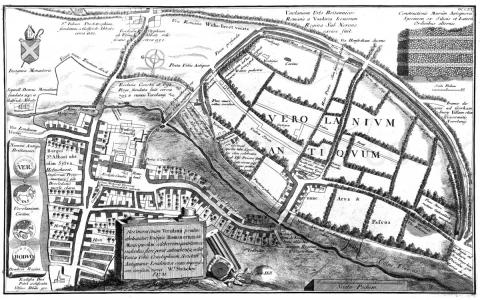
Hautville's Quoit [Map] lies across the River Chew from the Stanton Drew Stone Circles. Historic England 1002475:
The monument includes a recumbent standing stone, situated on a low rise just above the floodplain, in the valley of and overlooking the River Chew. The recumbent standing stone survives as an earthfast monolith partially buried into a bank and measuring at least 1m square by 0.3m high. The standing stone was recorded by Stukeley writing in 1723 as being one of a pair of stones, and it is known to have been recumbent since the mid-17th century. It is believed to be an outlier to the complex stone circle of Stanton Drew which is the subject of a separate scheduling.
The Beckhampton Avenue is an Avenue described by William Stukeley as connecting from Avebury Henge to the Long Stones Cove aka Devil's Quoits [Map]. At his time only thirty stones remained. Since then all have gone.
GrandFather: John Stukeley
Father: John Stukeley
GrandFather: Robert Bullen
Mother: Daughter Bullen